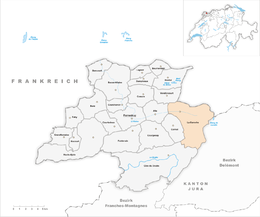La Baroche
| La Baroche | ||
|---|---|---|

Charmoille village church in La Baroche
|
||
|
||
| Coordinates: 47°25′N 07°10′E / 47.417°N 7.167°ECoordinates: 47°25′N 07°10′E / 47.417°N 7.167°E | ||
| Country | Switzerland | |
| Canton | Jura | |
| District | Porrentruy | |
| Government | ||
| • Mayor | Maire | |
| Area | ||
| • Total | 31.07 km2 (12.00 sq mi) | |
| Elevation | 479 m (1,572 ft) | |
| Population (Dec 2015) | ||
| • Total | 1,184 | |
| • Density | 38/km2 (99/sq mi) | |
| Postal code | 2946 | |
| SFOS number | 6810 | |
| Localities | Asuel, Charmoille, Fregiécourt, Miécourt, Pleujouse | |
| Website |
baroche SFSO statistics |
|
La Baroche is a municipality in the district of Porrentruy in the canton of Jura in Switzerland. It was founded at January 1, 2009 by the former municipalities of Asuel, Charmoille, Fregiécourt, Miécourt and Pleujouse.
Asuel is first mentioned in 1136 as Asuel. Charmoille is first mentioned in 1136 as Calmillis. Fregiécourt is first mentioned in 1136 as Frigiscurth. Miécourt is first mentioned in 866 as Curtem que Mietiam. Pleujouse is first mentioned in 1105 as de Pluiusa.
La Baroche has an area of 31.07 km2 (12.00 sq mi). Of this area, 15.24 km2 (5.88 sq mi) or 49.1% is used for agricultural purposes, while 14.18 km2 (5.47 sq mi) or 45.6% is forested. Of the rest of the land, 1.54 km2 (0.59 sq mi) or 5.0% is settled (buildings or roads), 0.09 km2 (22 acres) or 0.3% is either rivers or lakes and 0.06 km2 (15 acres) or 0.2% is unproductive land.
Of the built up area, housing and buildings made up 2.4% and transportation infrastructure made up 1.4%. Out of the forested land, 43.5% of the total land area is heavily forested and 2.1% is covered with orchards or small clusters of trees. Of the agricultural land, 22.3% is used for growing crops and 21.6% is pastures, while 2.3% is used for orchards or vine crops and 2.8% is used for alpine pastures. All the water in the municipality is flowing water.
La Baroche has a population (as of December 2015[update]) of 1,184. As of 2010[update], 5.8% of the population are resident foreign nationals. Over the last 10 years (2000–2010) the population has changed at a rate of -2.9%. Migration accounted for -2.5%, while births and deaths accounted for -0.3%.
Most of the population (as of 2000[update]) speaks French (90.2%) as their first language, German is the second most common (8.1%) and Italian is the third (0.8%).
...
Wikipedia




